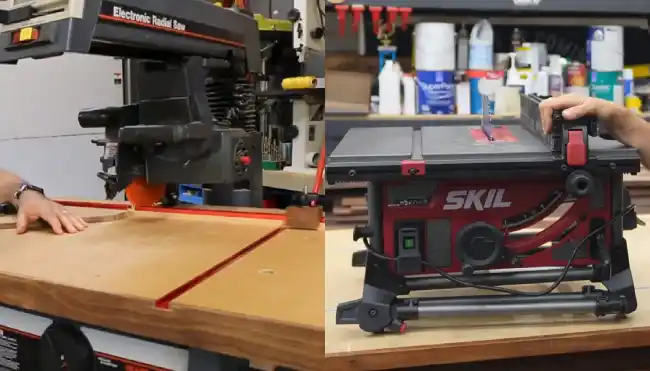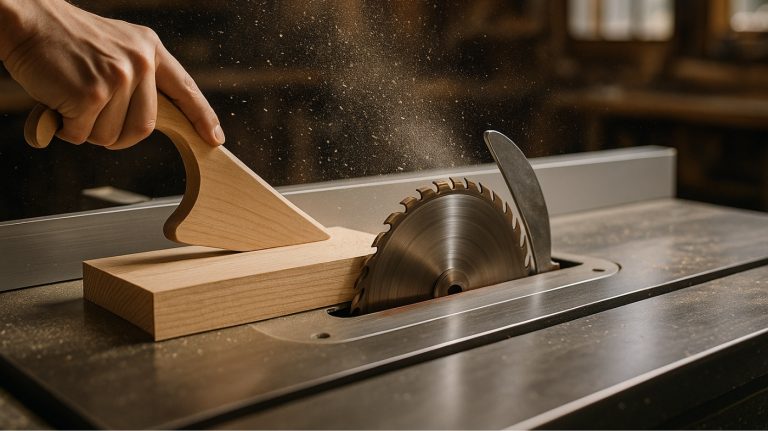Radial Arm Saw vs Table Saw: Differences
When embarking on a woodworking project, the saw you choose can significantly impact the quality of the outcome. Table saws and radial arm saws both have strengths and weaknesses, so choosing one can be tough. Both types of saws have their pros and cons, but they differ in a lot of ways.
While radial arm saws offer versatility and adaptability, they require more clearance space and pose a higher safety risk. Table saws excel in straight-line cuts and bevels, and are more common and affordable. So, think about your woodworking needs, space availability, and budget when choosing a saw.
Today we’ll discuss the differences between these two saws and help you decide which one is right for you. So, whether you’re a beginner or a seasoned woodworker, read on to find out which saw best fits your needs.
Radial Arm Saw vs Table Saw: Differences Between Them

For woodworking projects, you have two primary options: radial arm saws and table saws. While both saws can make clean, precise cuts, there are significant differences between them. These include:
- Cutting Action:
- Design and Clearance:
- Adaptability and Additional Tasks:
- Safety Considerations:
- Affordability and Availability:
- Space Requirement:
Cutting Action:
The radial arm saw’s cutting action is so smooth and effortless that’ll leave you wondering why you ever settled for a table saw. As the blade spins, it moves across the wood horizontally, slicing through it with ease.
With the saw, you can cut in either direction, which gives you more flexibility and precision. Furthermore, the radial arm saws design allows for more complex cuts, such as dados, rabbets, and grooves.
Conversely, the table saw’s cutting action is primarily designed for ripping along the grain of the wood. The blade moves vertically, allowing for straight-line cuts and bevel cuts. While the table saw can also perform crosscuts, it isn’t as efficient or precise as the radial arm saw.
Design and Clearance:
If you need a saw that won’t take up too much space, consider a radial arm saw. Its movable arm and suspended blade require clearance to the left and right, but not to the front and back, making it easy to place against a wall or in a corner.
In contrast, a table saw has a fixed blade attached to the table, requiring clearance on all sides for cuts. While this design is less flexible, it allows for more precise and accurate cuts, preferable for woodworkers prioritizing precision over space.
Adaptability and Additional Tasks:
If you want a versatile tool that can be adapted for non-cutting tasks, a radial arm saw is a great option. With the right attachments, you can use it for routing, planing, and sanding, saving you time and effort.
For example, you can use a router attachment to create decorative edges, or a sanding attachment to smooth out rough surfaces. This means you can tackle a wider range of woodworking projects with just one tool.
Comparatively, a table saw is primarily used for cutting and doesn’t typically offer attachments for non-cutting tasks. If you want to perform routing, planning, or sanding, you may need to purchase additional tools or machines. However, this can be more expensive and time-consuming in the long run.
Safety Considerations:
Table saws have a concealed blade that reduces the risk of accidents, but there are still safety considerations to remember. Always use a blade guard and anti-kickback features to prevent the wood from being thrown back at you.
Also, ensure the blade is sharp and properly aligned and that the fence is secure before making any cuts. Keep your hands away from the blade and use push sticks or blocks to guide the wood through the saw.
On the other hand, radial arm saws have exposed blades that pose a higher safety risk. In addition to the abovementioned precautions, it’s important to use appropriate safety measures when operating a radial arm saw.
One of the most important things to remember is to never reach over the blade while it’s in motion. Instead, turn the saw off and wait for the blade to come to a complete stop before adjusting or removing the wood.
| Safety Considerations | Table Saw | Radial Arm Saw |
| Blade Exposure | Concealed | Exposed |
| Blade Guard | Necessary | Necessary |
| Anti-Kickback Features | Necessary | Necessary |
| Hand Positioning | Away from Blade | Away from Blade, Never Over Blade |
Affordability and Availability:
Table saws are a cost-effective option for woodworkers of any skill level. With a variety of models at different price points, it’s easy to find one that suits your needs.
In comparison to a radial arm saw, a table saw is more affordable, making it accessible for those on a tight budget. Also, these saws are widely available both online and in hardware stores. Their popularity means that many resources are available to help you use them safely and effectively.
Space Requirement:
When selecting woodworking tools for a small workshop, take into account the space required for cutting. Radial arm saws have an advantage over table saws in terms of space requirements since they only need clearance on their sides. This makes them a great option for limited spaces.
In contrast, table saws require clearances on their front, back, and sides, making them take up more workspace. If you have the space and need the versatility that a table saw offers, then it might be worth the investment.
What is a radial arm saw most commonly used for?

A radial arm saw is primarily used for crosscutting wood, but it can rip along the grain if necessary. It’s commonly used in woodworking shops for various tasks such as cutting boards, creating grooves and joints, and making angled cuts.
This tool is favored by professional woodworkers and DIY enthusiasts for its accuracy and user-friendly design, allowing for quick and repetitive cuts. An added advantage of the radial arm saw is its ability to tilt the blade for angled cuts.
Is radial arm saw better than table saw?
If you’re looking for a versatile and easy-to-maintain tool for your woodworking projects, consider the radial arm saw. It’s great for making accurate cuts quickly and handling angled cuts that a table saw can’t. Also, it’s more versatile overall, as it can handle a wider variety of tasks.
With its overhead blade, maintenance is a breeze, meaning less time spent on upkeep and more time spent on your projects. And if space is an issue, the radial saw can be positioned against the wall for convenience.
Can a radial arm saw replace a table saw?
Radial arm saws can save you some space in your workshop if you’re looking to save some space. The horizontal arm of a radial arm saw requires less space than a table saw during ripping. This is particularly useful for small workshops.
However, radial arm saws are not as effective at cutting large lumber and have safety risks due to the blade’s traction causing. When deciding whether or not to replace your table saw, keep these things in mind.
What is the biggest disadvantage of a radial arm saw?
Radial arm saws require extra maintenance work to keep them in good condition. One major issue that can arise is the blade’s dullness, which can cause it to drive itself into the wooden workpiece during operation.
To better understand the drawbacks of radial arm saws, let’s compare them to table saws using a table:
| Radial Arm Saw | Table Saw | |
| Accuracy | Less accurate due to blade wobble | More accurate due to fixed blade position |
| Versatility | Can perform a variety of cuts | Limited to straight cuts |
| Safety | Blade can move unpredictably | Blade is fixed in place |
| Maintenance | Requires more maintenance | Requires less maintenance |
| Cost | More expensive | Less expensive |
As you can see, radial arm saws have some significant drawbacks when compared to table saws. While they may be more versatile regarding the types of cuts they can perform, their accuracy and safety can be compromised.
Is it safe to rip on a radial arm saw?
It’s not safe to rip lumber on a radial arm saw because of its design. The saw’s climbing force vector can cause kickbacks and accidents, and the blade’s rotation direction makes it challenging to control the wood.
A radial arm saw blade guard only covers the top of the blade, and their anti-kickback pawls aren’t as effective as the table saw ones. They are placed behind the blade, allowing the wood to move forward and cause a kickback.
Why should I use a table saw instead of a radial arm saw?

Table saws are a great choice for woodworking projects as they offer numerous advantages over radial arm saws. They are highly precise and enable you to make accurate cuts, which is crucial for achieving a quality finish in your projects.
Also, table saws are versatile and capable of making three types of cuts including cross cuts, ripping cuts, and dado cuts. Safety is also a major advantage of using a table saw.
Unlike a radial arm saw, the blade is positioned beneath the table, which means that wood is pushed through it, reducing the risk of kickback. To ensure safety, modern table saws are equipped with reliable features such as blade brakes, blade guards, and anti-kickback pawls.
Radial Arm Saw vs. Table Saw: Consider the Pros and Cons
When choosing a saw for your woodworking project, both radial arm saws and table saws have their own advantages and disadvantages. The radial arm saw is great for crosscuts, bevel cuts, and dado cuts, while the table saw is ideal for ripping, crosscutting, and making precise cuts.
But radial arm saws require less space but are generally more expensive, while the table saw is more affordable and commonly available. The adage ‘measure twice, cut once’ holds for both saws, as accuracy and safety should always be top priorities.
In the end, the choice depends on your specific needs and preferences. We hope this article has been informative and helpful in guiding you toward the right saw for your woodworking endeavors.







